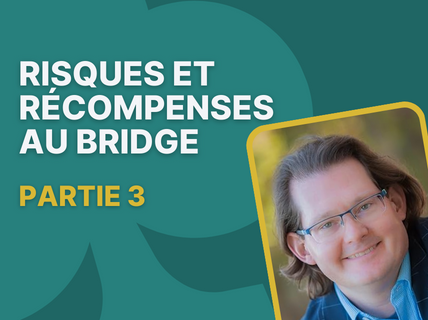


(Click here if you'd like to read Part 2 first)

When we play a session of bridge there’s more than one way to have an average game, and here are the ways that immediately spring to mind:
Note: We call this last type of bridge “pajama bridge” – tops and bottoms 🙂
Pajama bridge is more fun than having lots of average boards, and it also gives us more potential for improvement. When we have an average game because we had lots of good boards and lots of bad boards, then all we need to do now is eliminate the bad boards, and suddenly we have a great game! Of course, this is easier said than done.
But before we can learn how to eliminate our bad boards, we need to know the types of hands that tend to generate these “swingy” results. One of the most common hands that can result in either a very good or a very bad score is when we bid a slam. If we bid a slam and it makes, we usually get a very good board and if we go down, we will often get a very bad board.
Part of the reason slam deals generate a lot of swings is that on these boards there are a variety of different contracts played across the field of players. Compare a slam board to one where both players are balanced, there is no fit, and we have about 26-27 HCP. In that case, almost everyone in the event will play 3NT. When everyone is playing the same contract we are more likely to have a “flat board” which usually generates to only slightly above or slightly below average results.
On hands where slam might be bid, we see these types of actions:
This large variation in contracts and results means that the scoring is “all over the place”.
There are many slams that just seem obvious. Like when our side has 2 balanced hands, no fit, and 33-34 HCP - we would think that everyone would reach 6NT. But it always seems that bidding 6NT and making it is a better board than you would expect. Partnerships often have a bidding mixup with Gerber, Blackwood, or other conventions, and then don’t bid the grand (or even small) slam and go down.
Slam boards naturally generate a lot of variation in the final contract, and this creates opportunity for good and bad boards.
If our side has lots of HCP, then the variation in contract may be between which slam we bid – 6-minor, 6-Major, or 6NT. But if we bid a slam with only 29-31 HCP, we are likely to have an outlier, as many partnerships will not bid this slam. When we bid this slam we are making a judgement that we have at least one nice source of tricks and that many other players in the field will not be as aggressive, and are likely to stop in game. This means that these “pushy” slams come with a lot of risk, but also the possibility of big rewards. They’re either going to be great boards or disastrous ones!
One of the fun parts of playing bridge online is that we can often see how our game is going. If we are having a great game, we should try to keep our scores steady, by avoiding pushing for these “risky” slams. But if we’re having a below average or mediocre game then we should maybe bid some of these slams and view them as an opportunity to generate good results for our side.
Note: Learning to generate action is a skill that goes beyond slam bidding and is something to work on, as it can get you in a lot of trouble!
Slam bidding is fun! It is an opportunity to shine, or for disaster to ensue. Weigh up risk and reward as a part of your overall game, and take advantage of opportunities to generate top boards, or avoid bottom boards when these deals come your way.
Sobre el autor
Robert is a professional player and teacher who you’ll find all over North America (and the world). He's the founder of Adventures in Bridge and you'll find him hosting events, either virtual or in-person, almost every week of the year! Robert's also the president of the ACBL Educational Foundation where he's working to build an institution to shepherd the long term good of bridge!




I payed very much attention to your interesting letter.
I enjoyed reading all three of your Risk Verses Reward. Do you have a book on tips like this? Do you run weekend/week long conferences in England for assisted play improvement. If so I would be very interested in attending.
Very educational.I thoroughly enjoyed reading it.